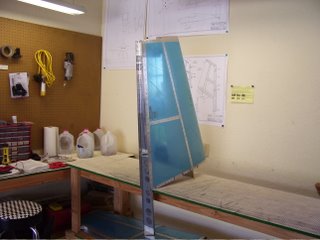
Today's efforts on the RV-7 kept me pretty busy. I got started on building the rudder skeleton in earnest. I had already cleco'd the R-904 bottom rib to the R-902 spar and enlarged the 0.125 hole in the center of rhe forward flange. The next step was to fabricate the R-917 shim out of the 0.032 material that came with the bundle of pieces of various sizes. The piece that I used was actually 40" long and 1 1/8" wide. I had to cut 3 1/2" of it off and then measure and drill 3 1/8" holes in the proper position as per the drawing.
Next I cleco'd the R-405PD rudder horn to the fudder spar and final drilled four holes through the upper edge of the rudder horn to #30 using the pre-punched holes in the spar as a guide. Then I cleco'd the rudder horn to the R-904 bottom rib to check the fit. It didn't very well so I had to use the Scotchbrite wheel to radius the top of the rudder horn unitl it would nest nicely in the radius of the rib flange.
Next, I Cleco'd the R-904 bottom rib and R-405PD rudder horn to the R-902 rudder spar. Then I slid the R-917 shim into place between the rudder spar and rudder horn and drilled it out to at #30 hole. Next step was to cleco the R-606PP, R-607PP, and R-608PP reinforcement plates to the R-902 rudder spar.
Moving on as per the plans, I fluted the R-903 tip rib and the R-912 counterbalance rib. With that done, I cleco'd them to the the top of the rudder spar and drilled to #30 holes. Then I cleco'd the R-913 counterbalance skin tothe R-903 tip rib and R-912 counterbalance rib. I match drilled to #40 holes the counterbalance skin to the ribs using the pre-punched holes in the R-913 counterbalance skin as a drill guide.
Now it was time to cleco the R-901R&L rudder skins to the ribs and spar. After that I fit the R-916 rudder trailing edge and cleco'd it into place. Then I drilled all the remaining holes in the rudder to the final size.
The next step was to trim the excess material from the R-710 rudder brace. After I got that done I fit it between the R-405PD and the R-904. The aft edge of the R-710 is cleco'd to the bottom of the R-904 and drilled to #30 holes. I matched drilled the forward edge of the R710 using the holes in the R-405PD as a drill guide.
Using the rest of the 0.032 material that I had used to make the R-917 shim, I made the R-918 rudder bottom attachment strips as shown on the drawing. These pieces are 18" long and have an angle on the forward end to fit to the R-710 rudder brace. When I finished makeing those pieces I used clamps to place them on the bottom of the rudder and drilled them by using the existing holes as drill guides.
It was a busy day.
5 HoursTotal hours on project = 89













